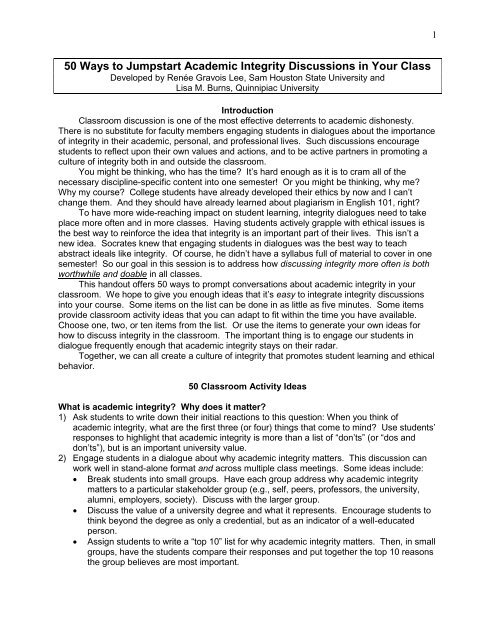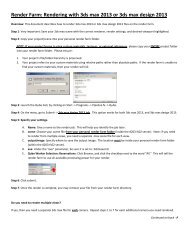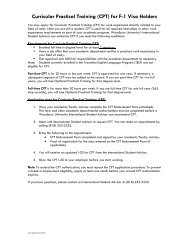50 Ways to Jumpstart Academic Integrity Discussions in Your Class
50 Ways to Jumpstart Academic Integrity Discussions in Your Class
50 Ways to Jumpstart Academic Integrity Discussions in Your Class
You also want an ePaper? Increase the reach of your titles
YUMPU automatically turns print PDFs into web optimized ePapers that Google loves.
1<strong>50</strong> <strong>Ways</strong> <strong>to</strong> <strong>Jumpstart</strong> <strong>Academic</strong> <strong>Integrity</strong> <strong>Discussions</strong> <strong>in</strong> <strong>Your</strong> <strong>Class</strong>Developed by Renée Gravois Lee, Sam Hous<strong>to</strong>n State University andLisa M. Burns, Qu<strong>in</strong>nipiac UniversityIntroduction<strong>Class</strong>room discussion is one of the most effective deterrents <strong>to</strong> academic dishonesty.There is no substitute for faculty members engag<strong>in</strong>g students <strong>in</strong> dialogues about the importanceof <strong>in</strong>tegrity <strong>in</strong> their academic, personal, and professional lives. Such discussions encouragestudents <strong>to</strong> reflect upon their own values and actions, and <strong>to</strong> be active partners <strong>in</strong> promot<strong>in</strong>g aculture of <strong>in</strong>tegrity both <strong>in</strong> and outside the classroom.You might be th<strong>in</strong>k<strong>in</strong>g, who has the time? It’s hard enough as it is <strong>to</strong> cram all of thenecessary discipl<strong>in</strong>e-specific content <strong>in</strong><strong>to</strong> one semester! Or you might be th<strong>in</strong>k<strong>in</strong>g, why me?Why my course? College students have already developed their ethics by now and I can’tchange them. And they should have already learned about plagiarism <strong>in</strong> English 101, right?To have more wide-reach<strong>in</strong>g impact on student learn<strong>in</strong>g, <strong>in</strong>tegrity dialogues need <strong>to</strong> takeplace more often and <strong>in</strong> more classes. Hav<strong>in</strong>g students actively grapple with ethical issues isthe best way <strong>to</strong> re<strong>in</strong>force the idea that <strong>in</strong>tegrity is an important part of their lives. This isn’t anew idea. Socrates knew that engag<strong>in</strong>g students <strong>in</strong> dialogues was the best way <strong>to</strong> teachabstract ideals like <strong>in</strong>tegrity. Of course, he didn’t have a syllabus full of material <strong>to</strong> cover <strong>in</strong> onesemester! So our goal <strong>in</strong> this session is <strong>to</strong> address how discuss<strong>in</strong>g <strong>in</strong>tegrity more often is bothworthwhile and doable <strong>in</strong> all classes.This handout offers <strong>50</strong> ways <strong>to</strong> prompt conversations about academic <strong>in</strong>tegrity <strong>in</strong> yourclassroom. We hope <strong>to</strong> give you enough ideas that it’s easy <strong>to</strong> <strong>in</strong>tegrate <strong>in</strong>tegrity discussions<strong>in</strong><strong>to</strong> your course. Some items on the list can be done <strong>in</strong> as little as five m<strong>in</strong>utes. Some itemsprovide classroom activity ideas that you can adapt <strong>to</strong> fit with<strong>in</strong> the time you have available.Choose one, two, or ten items from the list. Or use the items <strong>to</strong> generate your own ideas forhow <strong>to</strong> discuss <strong>in</strong>tegrity <strong>in</strong> the classroom. The important th<strong>in</strong>g is <strong>to</strong> engage our students <strong>in</strong>dialogue frequently enough that academic <strong>in</strong>tegrity stays on their radar.Together, we can all create a culture of <strong>in</strong>tegrity that promotes student learn<strong>in</strong>g and ethicalbehavior.<strong>50</strong> <strong>Class</strong>room Activity IdeasWhat is academic <strong>in</strong>tegrity? Why does it matter?1) Ask students <strong>to</strong> write down their <strong>in</strong>itial reactions <strong>to</strong> this question: When you th<strong>in</strong>k ofacademic <strong>in</strong>tegrity, what are the first three (or four) th<strong>in</strong>gs that come <strong>to</strong> m<strong>in</strong>d? Use students’responses <strong>to</strong> highlight that academic <strong>in</strong>tegrity is more than a list of “don’ts” (or “dos anddon’ts”), but is an important university value.2) Engage students <strong>in</strong> a dialogue about why academic <strong>in</strong>tegrity matters. This discussion canwork well <strong>in</strong> stand-alone format and across multiple class meet<strong>in</strong>gs. Some ideas <strong>in</strong>clude: Break students <strong>in</strong><strong>to</strong> small groups. Have each group address why academic <strong>in</strong>tegritymatters <strong>to</strong> a particular stakeholder group (e.g., self, peers, professors, the university,alumni, employers, society). Discuss with the larger group. Discuss the value of a university degree and what it represents. Encourage students <strong>to</strong>th<strong>in</strong>k beyond the degree as only a credential, but as an <strong>in</strong>dica<strong>to</strong>r of a well-educatedperson. Assign students <strong>to</strong> write a “<strong>to</strong>p 10” list for why academic <strong>in</strong>tegrity matters. Then, <strong>in</strong> smallgroups, have the students compare their responses and put <strong>to</strong>gether the <strong>to</strong>p 10 reasonsthe group believes are most important.
2 Discuss what it means <strong>to</strong> be a member of a scholarly community. This could <strong>in</strong>cludewhat it means <strong>to</strong> create knowledge and why issues of trust, responsibility, and <strong>in</strong>tegrityare essential <strong>to</strong> that process.3) Stage a debate on an issue such as “academic <strong>in</strong>tegrity only matters if you get caught.”Divide students <strong>in</strong><strong>to</strong> three teams: pro, con, and evalua<strong>to</strong>rs. The evalua<strong>to</strong>r team’s role is <strong>to</strong>assess the soundness of the arguments.4) Discuss academic <strong>in</strong>tegrity <strong>in</strong> relation <strong>to</strong> society’s focus on “gett<strong>in</strong>g ahead at all costs.”5) Give students 2-3-4 scenarios of academic dishonesty. Have students put themselves <strong>in</strong>the place of the offend<strong>in</strong>g student(s) and ask them <strong>to</strong> come up with other ways <strong>to</strong> resolvethe situation that would NOT result <strong>in</strong> <strong>in</strong>tegrity violations.6) Present this scenario: your roommate turned <strong>in</strong> a paper downloaded from a free essay site.Ask your students, how would you describe this person’s character? How would youdescribe this person’s capabilities? What k<strong>in</strong>d of employee do you th<strong>in</strong>k this person will bewhen she/he enters the professional workplace?7) Discuss the importance of codes of conduct. Have students develop a code of conduct foryour course.8) Discuss this quotation: “Rather fail with honor than succeed by fraud.” --Sophocles. Askyour students: How can you reconcile this position with your own needs <strong>to</strong> earn a certa<strong>in</strong>GPA <strong>to</strong> get <strong>in</strong><strong>to</strong> graduate school?9) Distribute a list of quotations about academic <strong>in</strong>tegrity, such as (from CAI website):“Every time I’ve done someth<strong>in</strong>g that doesn’t feel right, it’s ended up not be<strong>in</strong>g right.”--Mario Cuomo“To know what is right and not do it is the worst cowardice.” --Confucius“My grandfather once <strong>to</strong>ld me that there are two k<strong>in</strong>ds of people: those who work andthosewho take the credit. He <strong>to</strong>ld me <strong>to</strong> try <strong>to</strong> be <strong>in</strong> the first group; there was lesscompetitionthere.” --Indira Gandhi“What is right is often forgotten by what is convenient.” --Bodie ThoeneAsk students which quotes most resonate with them and why. For the next class, ask eachstudent <strong>to</strong> br<strong>in</strong>g three additional quotations that closely represent their own views on<strong>in</strong>tegrity. Discuss.10) Use case studies <strong>to</strong> highlight particular aspects of academic <strong>in</strong>tegrity you wish <strong>to</strong>emphasize. Case studies of all shapes and sizes are available, or write your own. Forexample, use a recent news s<strong>to</strong>ry about a professional ethical violation (there are plenty <strong>to</strong>chose from) <strong>to</strong> make connections between personal, academic, and professional <strong>in</strong>tegrity.What is the university’s policy? What are the professor’s course policies?11) Have a student member of your <strong>Academic</strong> <strong>Integrity</strong> Board come <strong>to</strong> your class <strong>to</strong> talk aboutyour school’s policy and why academic <strong>in</strong>tegrity matters.12) Instruct students <strong>to</strong> read the academic <strong>in</strong>tegrity policy before com<strong>in</strong>g <strong>to</strong> class. Possibleassignments: Give them a brief quiz. Have students self-correct. Discuss. Ask students <strong>to</strong> write down three th<strong>in</strong>gs they learned (or some other reflectiveassignment <strong>in</strong> relation <strong>to</strong> read<strong>in</strong>g the policy).Provide a scenario of a policy violation. Ask students <strong>to</strong> write down what penalty shouldbe rendered and why. In the next class, share some of the outcomes.13) Share anonymous reflections from a student who was sanctioned by the AI Board.14) Ask students <strong>to</strong> discuss plagiarism and the AI Policy specifically as it applies <strong>to</strong> your class.
315) Discuss when collaboration is and is not OK for your course. (See more detailed ideasbelow <strong>in</strong> collaboration section.)16) Involve students <strong>in</strong> discussion of “why” a particular behavior is or is not OK. Here’s oneexample: After you leave this class, you may be asked about the content of this exam by afriend who has the same class later <strong>to</strong>day.• Do you th<strong>in</strong>k this conversation might have an effect on your friend’s education?• Do you th<strong>in</strong>k it might affect your fellow students <strong>in</strong> this class? How?• How would you handle this situation?• Here’s what I believe…..Why is <strong>in</strong>tegrity important <strong>in</strong> the workplace?17) Assign students <strong>to</strong> f<strong>in</strong>d and read three newspaper articles about ethical lapses <strong>in</strong> theworkplace. Tell them <strong>to</strong> be prepared <strong>to</strong> start class discussion.18) Draw upon examples of <strong>in</strong>tegrity and breaches of <strong>in</strong>tegrity from current events, televisionprograms, movies, etc., particularly examples related <strong>to</strong> the subject matter of your course.Use these scenarios <strong>in</strong> class <strong>to</strong> jumpstart discussion. This is an easy way <strong>to</strong> discuss bothacademic and professional <strong>in</strong>tegrity <strong>in</strong> the context of your class.19) Assign a case about an ethical issue fac<strong>in</strong>g an entry-level employee.20) Give students a current ethical issue <strong>in</strong> your profession <strong>to</strong> debate. Divide students <strong>in</strong><strong>to</strong> threeteams: pro, con, and evalua<strong>to</strong>rs. The role of the evalua<strong>to</strong>rs is <strong>to</strong> assess the argumentsmade by each side.21) Discuss a high-profile case of plagiarism.22) Discuss the grow<strong>in</strong>g importance of teams <strong>in</strong> the workplace. Engage students <strong>in</strong> discussionabout team members pull<strong>in</strong>g their own weight (and not) and mak<strong>in</strong>g valuable contributions(and not). Then, have your students develop a list of guidel<strong>in</strong>es that will be used <strong>to</strong>govern/grade each team member’s participation <strong>in</strong> group projects <strong>in</strong> your class. Tellstudents that they will be responsible for hold<strong>in</strong>g each other accountable <strong>to</strong> those guidel<strong>in</strong>es.23) Give students this scenario: You are the head of your department at work. One of youremployees, Tim, called <strong>in</strong> sick <strong>to</strong>day. Later that night, you saw Tim at the xyz concert (hedidn’t see you). You are plann<strong>in</strong>g <strong>to</strong> talk with Tim when he returns <strong>to</strong> work. Write down thepo<strong>in</strong>ts you want <strong>to</strong> discuss with him. Now pretend you are Tim. You know the boss saw youat the concert. Should you do anyth<strong>in</strong>g? If so, what? Be specific.Doesn’t everyone cheat <strong>in</strong> some way <strong>to</strong> get ahead? No. Discuss tak<strong>in</strong>g responsibility foryour actions.24) Give students this scenario: <strong>Your</strong> just <strong>to</strong>ok a test worth 20% of your grade. After tak<strong>in</strong>g thetest, you overheard three students bragg<strong>in</strong>g about cheat<strong>in</strong>g and how well they had done onthe test. Write an anonymous letter tell<strong>in</strong>g each of them what you th<strong>in</strong>k.25) Ask students why they believe students cheat. Write down the students’ list of reasons onthe blackboard or overhead, then have students prioritize the reasons. Ask them if anyreasons are acceptable <strong>to</strong> excuse cheat<strong>in</strong>g.Next class, distribute the list of common reasons/excuses for academic dishonesty thatyour students developed. Break students <strong>in</strong><strong>to</strong> teams of two and assign each team twoor more of the excuses. Have each team a) evaluate the excuses and b) developalternatives <strong>to</strong> act<strong>in</strong>g dishonestly.26) Give students this scenario: It’s two days before your paper is due and you haven’t started.What are some honest ways <strong>to</strong> resolve your predicament?27) Present this scenario: A student earned a f<strong>in</strong>al course grade of C. After course gradeswere turned <strong>in</strong>, the student compla<strong>in</strong>ed that the professor had “given” this grade, and askedfor extra credit <strong>to</strong> improve the grade <strong>to</strong> a B- because “I need a B average <strong>to</strong> keep my
4scholarship.” If you were the professor, how would you respond? Next class, distribute thestudents’ written responses and discuss.28) Have students break <strong>in</strong><strong>to</strong> small groups and discuss some scenarios related <strong>to</strong> classroommisconduct that are not specifically related <strong>to</strong> the “work” <strong>in</strong> the course. Some examples:• Sign<strong>in</strong>g an attendance sheet for a friend.• Ly<strong>in</strong>g about be<strong>in</strong>g ill <strong>to</strong> ask for a make-up exam on a later date.• Ly<strong>in</strong>g about a sick relative <strong>to</strong> get an extension on a paper.• Say<strong>in</strong>g that your friend’s mother died <strong>to</strong> justify turn<strong>in</strong>g <strong>in</strong> an assignment late.Have students generate additional examples and discuss each item on the list. With theentire class, discuss how ga<strong>in</strong><strong>in</strong>g unfair advantage IS related <strong>to</strong> the work (or some otherdiscussion prompt).29) Observation exercise. Instruct students <strong>to</strong> keep an anonymous “gett<strong>in</strong>g ahead” journal forone week, <strong>in</strong> which they write down examples of dishonest th<strong>in</strong>gs they notice people(<strong>in</strong>clud<strong>in</strong>g themselves) do<strong>in</strong>g <strong>to</strong> get ahead. Encourage them <strong>to</strong> observe “gett<strong>in</strong>g ahead”behaviors dur<strong>in</strong>g whatever television shows they watch that week, <strong>to</strong>o. Ask students <strong>to</strong> payparticular attention <strong>to</strong> “white lies” and how they are used <strong>to</strong> get ahead. At the end of theweek of observation, have students make a list of all dishonest behaviors they observed, aswell as behaviors that COULD be perceived as dishonest. Discuss f<strong>in</strong>d<strong>in</strong>gs <strong>in</strong> class.(Request<strong>in</strong>g anonymous papers for this activity is an option, <strong>to</strong>o).What is plagiarism?30) Ask students <strong>to</strong> write down the mean<strong>in</strong>g of plagiarism <strong>in</strong> their own words, look up apublished def<strong>in</strong>ition, and compare the two.31) Announce the university’s Learn<strong>in</strong>g Center programs on academic <strong>in</strong>tegrity issues. Use thatdiscussion <strong>to</strong> highlight a plagiarism issue(s) of your choice.32) Devote a class period <strong>to</strong> academic <strong>in</strong>tegrity, offer<strong>in</strong>g samples of students’ problems anderrors that you personally have encountered <strong>in</strong> your classes.33) Assign students an onl<strong>in</strong>e plagiarism test such as www.plagiarismtest.org orhttp://education.<strong>in</strong>diana.edu/~frick/plagiarism. Instruct them <strong>to</strong> take the test as many timesas it takes <strong>to</strong> achieve a perfect score. In the next class, have students write down twolearn<strong>in</strong>g po<strong>in</strong>ts they found most valuable. Pick up those written comments. Discuss a fewwith the entire class.34) Have students proofread a paper that has multiple examples of plagiarism. Next class, talkabout what they found.35) Show students a plagiarized paper. Ask, why might a student have turned <strong>in</strong> such a paper?What alternative actions could the student have taken?36) Include questions about plagiarism on a quiz or exam.37) Have students peer-edit each other’s work, focus<strong>in</strong>g on plagiarism.38) Have students debate the idea that “students should not be held responsible for plagiarism ifthey don’t understand it.” Use that debate <strong>to</strong> discuss un<strong>in</strong>tentional plagiarism and whywriters (<strong>in</strong>clud<strong>in</strong>g students) must be held accountable for plagiarism even when it may beun<strong>in</strong>tentional. Engage students <strong>in</strong> a discussion about their responsibilities.What am I do<strong>in</strong>g wrong <strong>in</strong> my paper?The ideas <strong>in</strong> this section are based on student writ<strong>in</strong>g problems we have encountered <strong>in</strong> ourclasses most often.Paraphras<strong>in</strong>g39) Have students write down, <strong>in</strong> their own words, why paraphrased ideas, not just directquotes, must be cited.40) Show examples of adequate and <strong>in</strong>adequate paraphras<strong>in</strong>g. Discuss.
541) Give students a passage <strong>to</strong> paraphrase. Have students trade papers, do peer reviews,and revise papers based on the peer feedback. Give group (vs. <strong>in</strong>dividual) feedback <strong>to</strong>the class, then have students rewrite aga<strong>in</strong>. Discuss key challenges studentsexperienced try<strong>in</strong>g <strong>to</strong> paraphrase.Cut-and-Paste Problems42) Discuss how “compil<strong>in</strong>g” a paper is different from “writ<strong>in</strong>g” a paper. Have each personwrite down 3-5 disadvantages of submitt<strong>in</strong>g a compiled paper. Discuss.43) In front of the class, illustrate how students sometimes “compile” papers by cutt<strong>in</strong>g andpast<strong>in</strong>g selections from other sources and mak<strong>in</strong>g superficial changes. Discuss.44) Show multiple variations of the cut-and-paste problem <strong>to</strong> help students see howcopy<strong>in</strong>g is wrong whether it’s one sentence, one paragraph, one page, or more. Havestudents rewrite selected passages us<strong>in</strong>g appropriate paraphras<strong>in</strong>g.Paper Mills, Buy<strong>in</strong>g Papers, and Other Steal<strong>in</strong>g45) In front of the class, critique a paper from an onl<strong>in</strong>e paper mill such aswww.cheathouse.com or www.schoolsucks.com. This activity can serve multiplepurposes such as teach<strong>in</strong>g about plagiarism prevention and proper citation, clue<strong>in</strong>gstudents <strong>in</strong> that you are aware of onl<strong>in</strong>e paper mills, and demonstrat<strong>in</strong>g the low qualitypapers they are likely <strong>to</strong> get from such sites.46) Present this scenario: your roommate reveals <strong>to</strong> you at midnight that she isdownload<strong>in</strong>g a paper from a free essay site because she is “freak<strong>in</strong>g out” that herpaper is due <strong>to</strong>morrow and she’s not ready. Should you do anyth<strong>in</strong>g? If not, why? Ifso, why and what?47) Discuss this scenario: <strong>Your</strong> roommate is mak<strong>in</strong>g money by writ<strong>in</strong>g papers for otherpeople. What do you do?What’s wrong with work<strong>in</strong>g <strong>to</strong>gether/collaborat<strong>in</strong>g on this assignment?48) Present a scenario such as this one: <strong>Your</strong> roommate asks if you have f<strong>in</strong>ished your paperand you say yes. She asks you <strong>to</strong> e-mail her your paper <strong>to</strong> give her some ideas <strong>to</strong> start herpaper. Discuss the follow<strong>in</strong>g:• How would you handle this situation? List at least three possibilities.• Discuss the implications of this situation for you? <strong>Your</strong> friend? Others?• What are various ways this situation could unfold? List several.49) Present 1-2 scenarios of collaboration issues your students might face, such as: Lab report <strong>in</strong> a science class A take-home test A homework assignment that it’s OK <strong>to</strong> discuss, but must be WRITTEN <strong>in</strong>dividually A group member not pull<strong>in</strong>g her/his share, but tak<strong>in</strong>g creditAsk students <strong>to</strong> develop possible ways <strong>to</strong> approach the situation and recommend a courseof action. Discuss what is and is not OK for your course. Discuss how students must know(and ask!) what’s OK for EACH course.<strong>50</strong>) Present a scenario such as this one: “<strong>Your</strong> roommate reviewed your paper and: Circlederrors. Corrected errors. Rewrote a few sentences. Rewrote several large passages. Gaveyou ideas for how <strong>to</strong> better construct your argument.” Ask students which of these actions areOK or not. Have your students grapple with collaboration that is acceptable and collaborationthat crosses the l<strong>in</strong>e. Be specific about what is and is not OK for your course.








